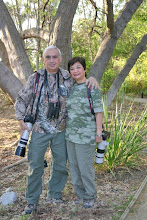This time Cynthia and I went to Metropolitan Park early. A little after 7 am and we were exploring the trails hoping to see more lifers. And we did! Not as many as the day before, but still we were happy with what had seen.
One of our target birds here was the Keel-billed Toucan. Although quite common - we've seen them at the hotel grounds - they were always high up in the trees and quite difficult to photograph. That puzzled me because we have seen pictures of this species that apparently were taken at close range here in Panama. Even some of the birders we met at the hotel told us that they have seen the Toucan quite close. Anyway, I finally was able to get a good enough shot of this bird. It was still high up in the trees but at least it was not backlit as those we've seen at the hotel.
Another prize catch and lifer we got here was the Lance-tailed Manakin.
A Green Shrike-vireo was a welcome addition to our life list.
Despite its name, the Plain-brown Woodcreeper was still a beauty to behold.
In contrast, the aptly-named Orange-billed Sparrow was another lifer for us.
Finally, the noisy Yellow-backed Oriole called our attention to itself.
We returned to our hotel after lunch. Later in the afternoon we decided to make one final birding foray at the area near the pond. The "Tero" or Southern Lapwing was even more confiding. It came to just about a few feet from us as it looked for its dinner in a most interesting way. It would stand still and with one foot probe the grass beneath hoping to flush some insect or worm or even a frog or toad into the open.
At sunset, as we were approaching the area behind the hotel, we met some birders. One of them, a British gentleman, was taking photos of what I thought was merely the common Great-tailed Grackle. "Collared Aracari" the gentleman said. I quickly aimed my gear at the silhouetted bird and took several shots. Just like the Keel-billed Toucan, this similarly-shaped bird is quite common here, and also just like the toucan, it preferred the tall trees - at least at the times we saw it. The Collared Aracari was our "goodbye bird" here. Tomorrow, we will be transferring to a hotel closer to the airport.
The starbird of the day, however, was seen just before the encounter with the Collared Aracari. It was the golden hour as the setting sun filled the skies with a yellow-orange glow. As we were going up to the parking lot, I saw a raptor fly from the golf-practice area to the main course. I managed to fire off only a total of four shots! Thankfully, one was clear enough for me to be able to identify this bird. It was a Laughing Falcon!
Goodbye, Radisson Summit Hotel, and thank you for the many lifers we got at your premises.
Hen Harrier at Long Last!
6 days ago






















































